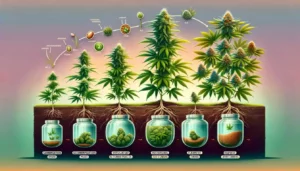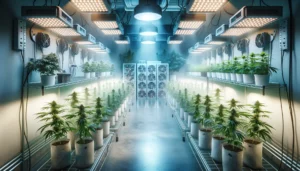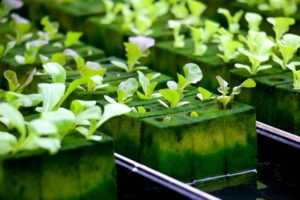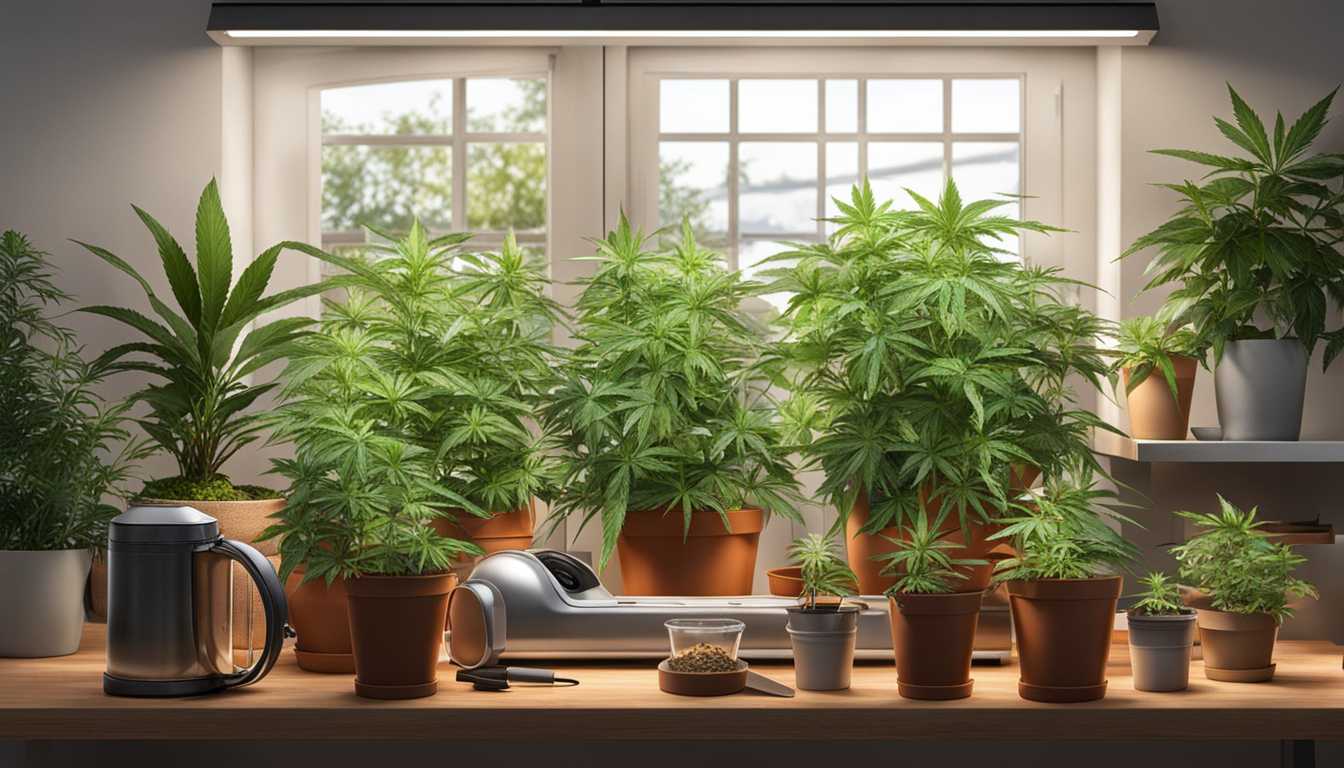This professional guide provides insights into the basic design principles of an indoor cannabis grow room. It is intended to help both beginners and seasoned cultivators understand the intricacies involved in creating an efficient and productive indoor cannabis cultivation environment. Emphasizing ‘grow room design basics’ and ‘indoor cannabis cultivation design’, the guide discusses various factors that influence the yield and quality of the crop.
Grow Room Design Basics: Where to Start?
When it comes to designing an indoor cannabis grow room, it is crucial to have a solid understanding of the basics. The design of your grow room will directly impact the success of your cannabis cultivation, so it is essential to start on the right foot. To begin, consider the size and layout of the space you have available. This will determine how many plants you can grow and what equipment you will need. Additionally, think about factors such as access to electricity, water sources, and ventilation. These are all critical aspects that must be addressed in the initial planning stages. Once you have a clear idea of the space and its limitations, you can move on to selecting the appropriate equipment, such as lighting, ventilation systems, and climate control devices. These choices will depend on factors such as your budget, the number of plants you plan to grow, and your desired growth methods. Finally, don’t forget about the importance of security. Indoor cannabis cultivation can attract unwanted attention, so it is crucial to keep your grow room discreet and secure. Consider factors such as access control, surveillance systems, and odor control to ensure a safe and discreet operation. By starting with these basic design principles, you will set the foundation for a successful indoor cannabis cultivation operation.
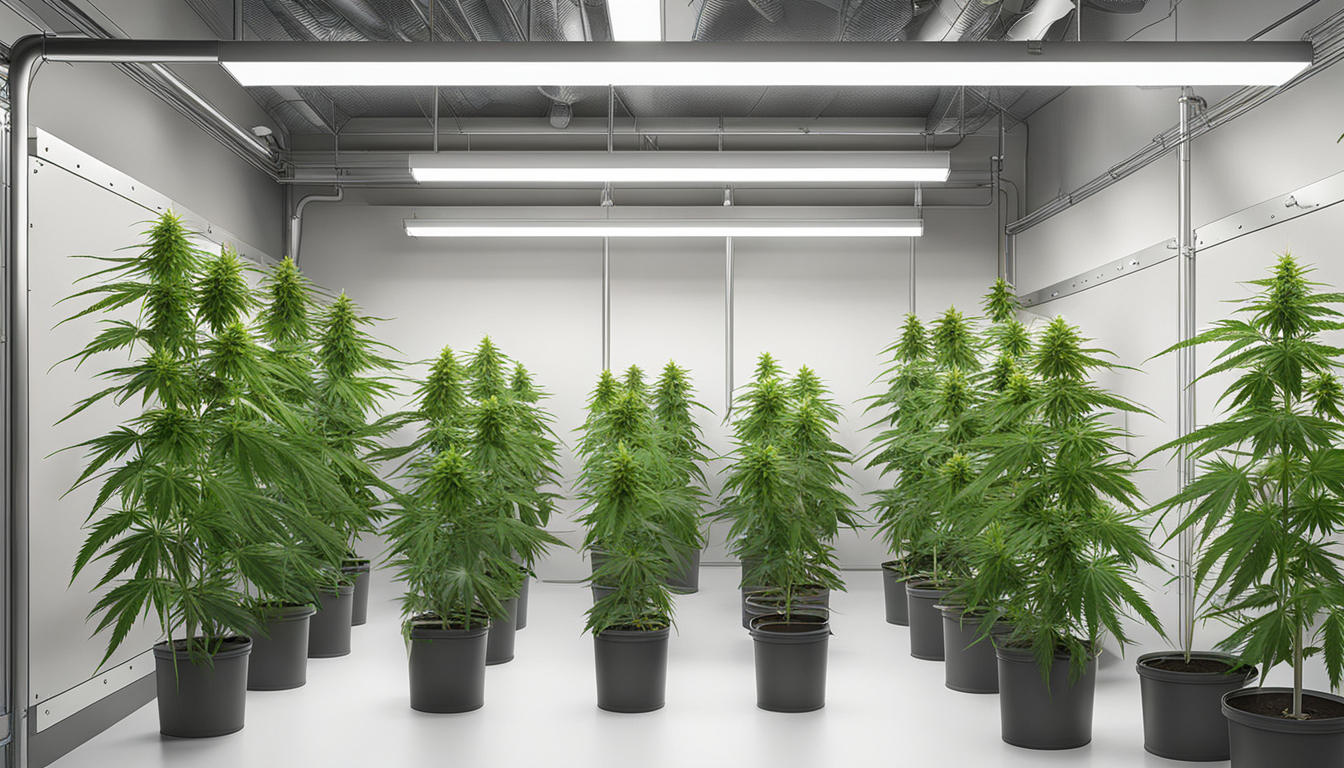
Illustration of a basic grow room design layout
Understanding the Importance of Space Selection
When it comes to indoor cannabis cultivation, choosing the right space is of utmost importance. The space you choose will directly impact the success of your plants and the overall efficiency of your operation. There are several factors to consider when choosing a space for your grow room.
First and foremost, you need to ensure that the space provides enough room for your plants to grow and thrive. Consider the height of the space, as cannabis plants can grow quite tall. Additionally, think about the floor space available and how many plants you plan to grow. It is essential to provide enough space between plants to allow for proper air circulation and prevent overcrowding.
Another crucial factor to consider is access to resources. Your grow room should be located near a reliable source of electricity and water. Cannabis plants require specific lighting and watering schedules, so having easy access to these resources will make your cultivation process much smoother.
Additionally, consider the location of the space in terms of security and discretion. It is important to keep your cannabis cultivation operation low-key and secure, especially in areas where it may not be legal. Choose a space that is less visible from the outside and take measures to enhance security, such as installing blackout curtains and reinforcing doors and windows.
Finally, take into account the environmental conditions of the space. Is it prone to extreme temperature fluctuations? Does it have adequate ventilation? These factors will play a significant role in the success of your cultivation. Ideally, select a space that can be easily controlled and maintained at optimal temperature and humidity levels.
Choosing the Right Lighting: Quantity or Quality?
When it comes to indoor cannabis cultivation, lighting is a critical factor that directly impacts the growth and development of your plants. When choosing the right lighting for your grow room, you need to consider whether to prioritize quantity or quality.
Quantity refers to the intensity and coverage of the light. Cannabis plants require a significant amount of light to grow and produce high-quality buds. High-intensity discharge (HID) lights, such as metal halide (MH) and high-pressure sodium (HPS) lamps, are popular choices for providing ample light intensity. They offer a wide coverage area and are known for their ability to stimulate plant growth.
On the other hand, quality refers to the spectrum of light emitted by the bulbs. Different light spectrums have varying effects on plant growth and development. Full-spectrum LED lights have gained popularity in recent years due to their ability to provide a balanced spectrum that closely mimics natural sunlight. LED lights are energy-efficient and allow for more precise control of the light spectrum, which can be beneficial during different stages of plant growth.
Ultimately, the choice between quantity and quality of lighting depends on your specific goals and budget. If you have a larger grow room and prioritize high yields, HID lights may be a suitable option. However, if you are concerned about energy consumption and want more control over the light spectrum, LED lights may be a better choice.
It is important to note that lighting requirements may vary depending on the stage of plant growth. For instance, during the vegetative stage, plants require more blue light, while during the flowering stage, they need more red light. Consider investing in adjustable lighting systems that allow you to customize the light spectrum based on the specific needs of your plants.
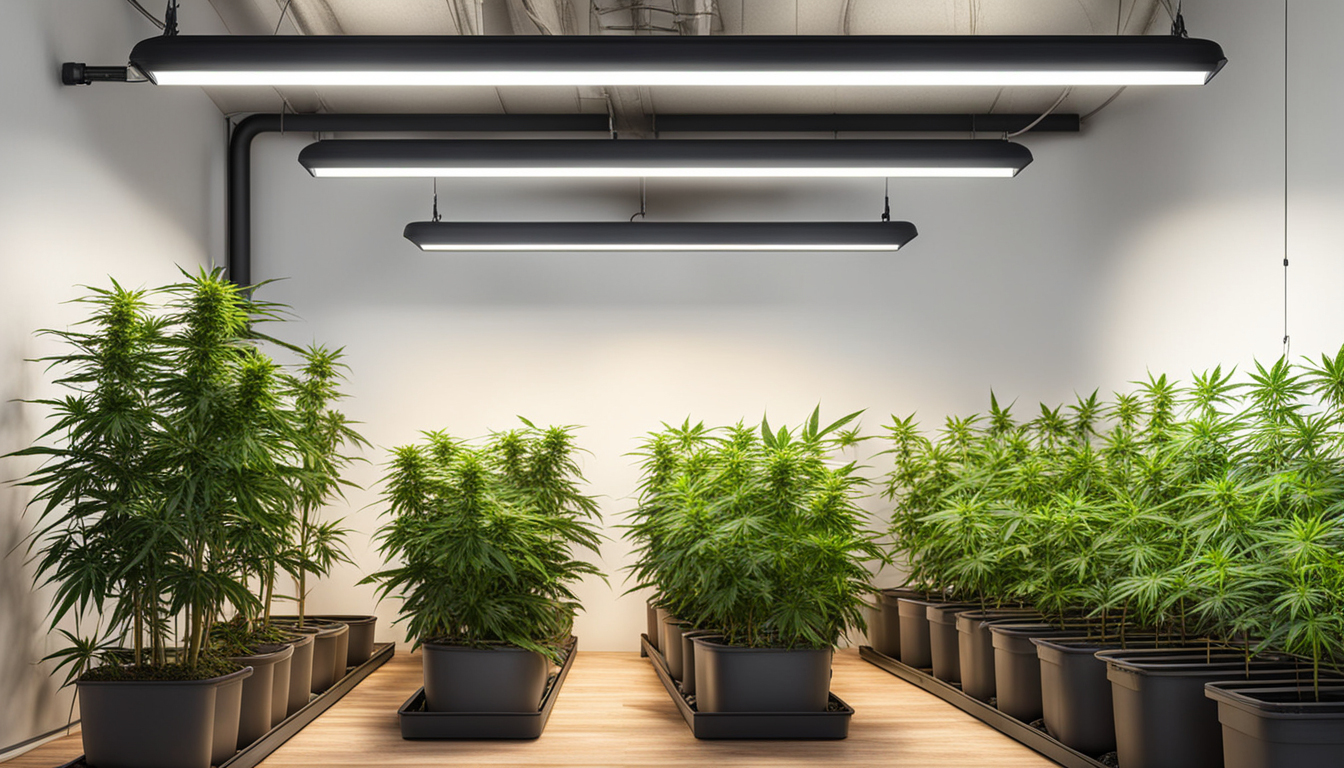
Image comparison of different lighting setups for cannabis cultivation
Ventilation: The Breath of Life in Cannabis Cultivation
Proper ventilation is essential for a successful indoor cannabis cultivation setup. It plays a crucial role in maintaining a healthy and optimal environment for your plants. Ventilation helps to remove stale air, control humidity levels, and provide a steady supply of fresh air and CO2.
First and foremost, adequate airflow helps to prevent the buildup of excess heat and humidity, which can lead to various issues such as mold, mildew, and pests. By exchanging the air in the grow room, you can maintain a consistent temperature and humidity level, creating an ideal environment for your plants to thrive.
Additionally, ventilation helps to supply plants with the necessary CO2 for photosynthesis. During the process of photosynthesis, plants convert CO2 into oxygen, which is vital for their growth and development. Proper ventilation ensures a constant supply of fresh air, enabling plants to efficiently carry out the process and produce energy.
There are different types of ventilation systems to consider for your grow room. One popular option is using exhaust fans to remove stale air and bring in fresh air. Inline fans combined with carbon filters can help to control odors, especially during the flowering stage when the plants emit strong smells.
It is important to properly size your ventilation system based on the size of your grow room and the number of plants. Calculating the required CFM (cubic feet per minute) helps ensure sufficient airflow for optimal plant growth. Additionally, installing oscillating fans within the grow room helps to promote air circulation and prevent stagnant pockets of air.
Climate Control: The Little Differences That Matter
Creating and maintaining the right climate within your indoor cannabis grow room is crucial for the success of your cultivation. Even small variations in temperature, humidity, and CO2 levels can have a significant impact on plant health and yield. Therefore, it is essential to implement effective climate control measures to ensure optimal growing conditions.
Temperature control is one of the key aspects of climate control in indoor cannabis cultivation. Different stages of plant growth require specific temperature ranges. Generally, a temperature range of 70-85°F (21-29°C) is suitable for most cannabis strains during the vegetative stage, while a slightly lower range of 65-80°F (18-27°C) is preferred during the flowering stage. Maintaining a consistent temperature within these ranges helps to promote healthy growth and prevent stress or damage to the plants.
Humidity levels also play a crucial role in cannabis cultivation. During the vegetative stage, higher humidity levels between 50-70% are desirable, as it aids in transpiration and nutrient uptake. However, during the flowering stage, it is important to reduce humidity levels to prevent issues like mold and mildew. Lowering humidity to around 40-50% helps to maintain a dry environment and protect the flowers.
CO2 supplementation is another factor to consider for optimal climate control. Increasing CO2 levels in the grow room can enhance plant growth and yield. While the ambient CO2 levels are around 400 ppm, supplementing with additional CO2 to reach 1000-1500 ppm during the light cycle can significantly benefit cannabis plants. CO2 generators or tanks can be used to introduce CO2 into the grow room, ensuring that plants have an adequate supply for photosynthesis.
To achieve precise climate control, it is recommended to use climate control devices such as thermostats, humidity controllers, and CO2 monitors. These devices help maintain consistent environmental conditions by automatically adjusting temperature, humidity, and CO2 levels as needed.
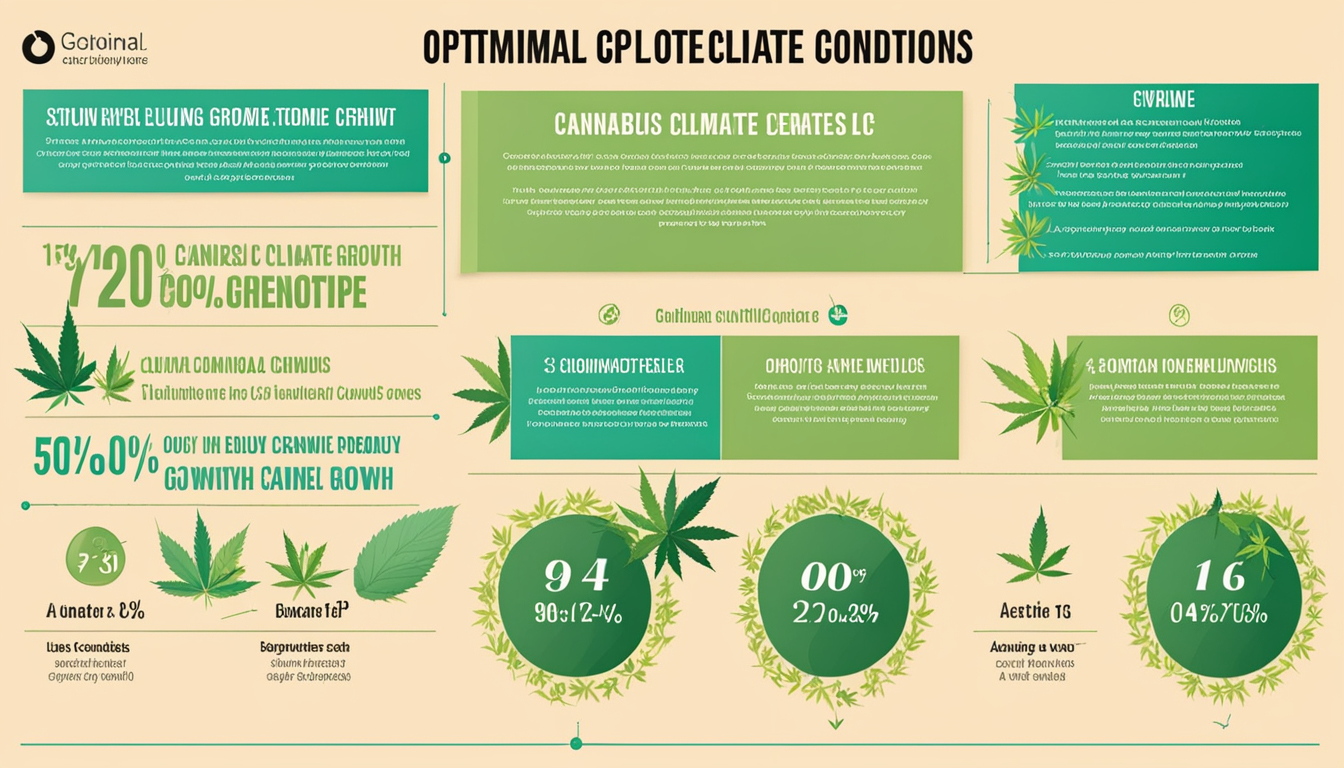
Infographic showing optimal climate conditions for cannabis growth
Hydroponics or Soil: Which is Better for Indoor Cultivation?
When it comes to indoor cannabis cultivation, growers have the option to choose between hydroponics or soil as their growing medium. Both methods have their advantages and disadvantages, and the decision ultimately depends on the grower’s preferences and goals.
Hydroponics is a soilless growing technique that involves growing plants in a nutrient-rich water solution. This method allows for precise control over nutrient delivery, pH levels, and water content. It also promotes faster growth and higher yields due to the increased availability of oxygen and nutrients to the roots. Additionally, hydroponics systems are generally more space-efficient and can be set up in smaller areas. However, hydroponic systems require more attention to detail and maintenance, as any imbalance in nutrient levels or pH can have detrimental effects on plant health.
On the other hand, soil cultivation is a more traditional approach that utilizes organic or synthetic soil mixes. Many growers prefer soil because it is considered more forgiving and easier to manage compared to hydroponics. Soil provides a natural buffer and retains moisture, reducing the risk of over or under watering. It also contains beneficial microorganisms that aid in nutrient uptake and plant health. However, soil cultivation generally requires larger pots or containers, which can limit the number of plants that can be grown in a given space. Soil may also be prone to pests, and its nutrient content may vary, requiring regular monitoring and supplementation.
What’s Next? The Future of Indoor Cannabis Cultivation
As the cannabis industry continues to evolve and gain acceptance, the future of indoor cannabis cultivation looks promising. Advancements in technology and research are driving innovation in grow room design and cultivation techniques. One area of focus is sustainable and energy-efficient practices. Growers are increasingly implementing LED lighting systems, which consume less energy and produce less heat compared to traditional lighting options. This not only reduces operational costs but also minimizes the environmental impact of indoor cultivation. Additionally, advancements in automation and remote monitoring systems allow growers to optimize and manage their grow rooms more efficiently. This technology enables real-time monitoring of environmental conditions, nutrient delivery, and even pest detection. As a result, growers can make data-driven decisions, improve crop quality, and maximize yields. Furthermore, genetic research and breeding programs are leading to the development of new cannabis strains that are specifically tailored for indoor cultivation. These strains exhibit traits such as compact growth, high yields, and resistance to common pests and diseases. Such advancements allow growers to optimize their cultivation spaces and achieve consistent, high-quality harvests. Finally, the legalization of cannabis in more regions and countries opens up opportunities for larger-scale indoor cultivation operations. This can lead to increased investment in research and development, further driving innovation in grow room design and cultivation practices. Overall, the future of indoor cannabis cultivation is exciting and holds great potential for improved efficiency, sustainability, and the development of new and innovative techniques. As the industry continues to grow, it is important for growers to stay informed and adapt to the changing landscape to remain competitive and successful.

Conceptual image of a futuristic indoor cannabis cultivation setup
Indoor Cannabis Cultivation Basics:
| Grow Room Design | Indoor Cannabis Cultivation Design | Factors That Influence Yield | Factors That Influence Quality |
|---|---|---|---|
| Lighting, Ventilation, Temperature, Humidity | Nutrient Management, Water Management, Light Management | Growth Conditions, Genetics, Plant Training Techniques | Curing Techniques, Storage Conditions, Pest Control |
| Optimal Size, Insulation, Electrical Requirements | Mediums Used, Environmental Controls, Automation | Harvest Timing, Pruning, pH Levels | Flushing, Trimming, Product Selection |
| Odor Control, Filtering, Sanitation Practices | Co2 Enrichment, Automated Systems, Lighting Schedules | Weather Conditions, Water Quality, Nutrient Quality | Curing Techniques, Flushing, Product Selection |
| Airflow, Temperature Control, Lighting System | Nutrient Management, Automation, Environmental Controls | Strain Selection, Plant Training Techniques, pH Levels | Curing Techniques, Storage Conditions, Trimming |
Indoor cannabis cultivation requires a well-structured design and an understanding of the grow room basics. The guide covers all aspects of the design, from space selection to lighting, ventilation and more. By following these guidelines, cultivators can ensure a successful and productive grow operation, regardless of their level of expertise.

